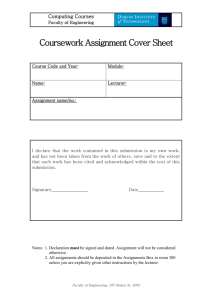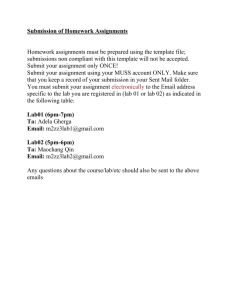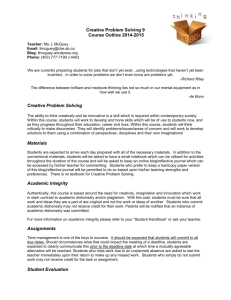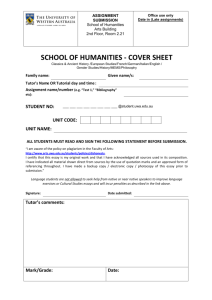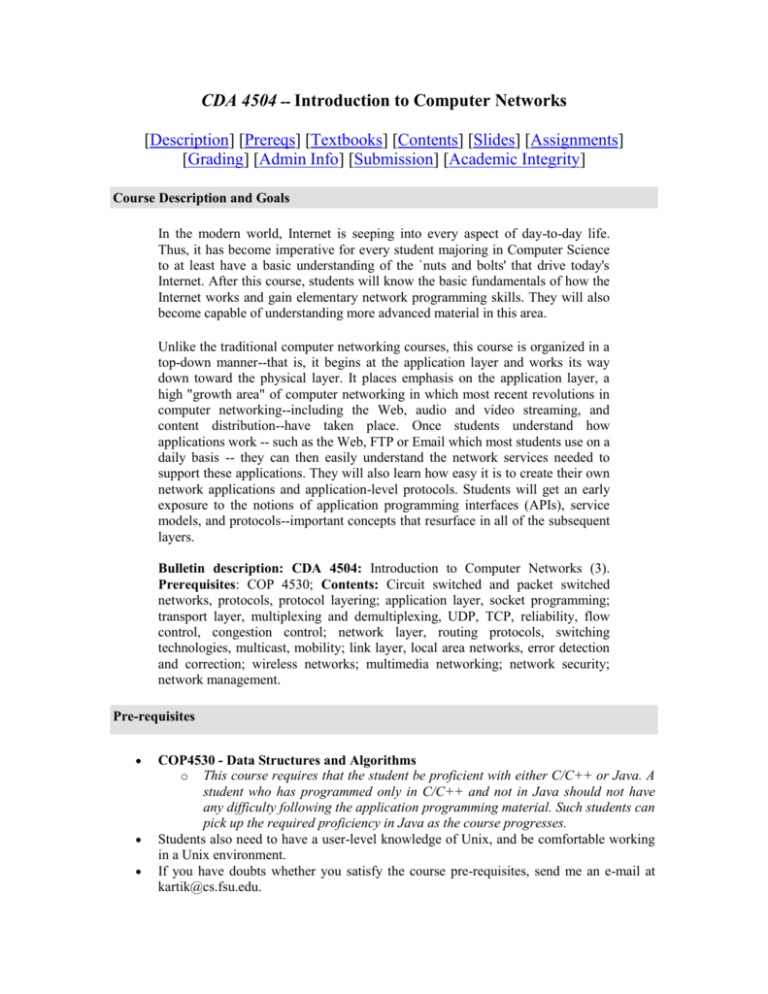
CDA 4504 -- Introduction to Computer Networks
[Description] [Prereqs] [Textbooks] [Contents] [Slides] [Assignments]
[Grading] [Admin Info] [Submission] [Academic Integrity]
Course Description and Goals
In the modern world, Internet is seeping into every aspect of day-to-day life.
Thus, it has become imperative for every student majoring in Computer Science
to at least have a basic understanding of the `nuts and bolts' that drive today's
Internet. After this course, students will know the basic fundamentals of how the
Internet works and gain elementary network programming skills. They will also
become capable of understanding more advanced material in this area.
Unlike the traditional computer networking courses, this course is organized in a
top-down manner--that is, it begins at the application layer and works its way
down toward the physical layer. It places emphasis on the application layer, a
high "growth area" of computer networking in which most recent revolutions in
computer networking--including the Web, audio and video streaming, and
content distribution--have taken place. Once students understand how
applications work -- such as the Web, FTP or Email which most students use on a
daily basis -- they can then easily understand the network services needed to
support these applications. They will also learn how easy it is to create their own
network applications and application-level protocols. Students will get an early
exposure to the notions of application programming interfaces (APIs), service
models, and protocols--important concepts that resurface in all of the subsequent
layers.
Bulletin description: CDA 4504: Introduction to Computer Networks (3).
Prerequisites: COP 4530; Contents: Circuit switched and packet switched
networks, protocols, protocol layering; application layer, socket programming;
transport layer, multiplexing and demultiplexing, UDP, TCP, reliability, flow
control, congestion control; network layer, routing protocols, switching
technologies, multicast, mobility; link layer, local area networks, error detection
and correction; wireless networks; multimedia networking; network security;
network management.
Pre-requisites
COP4530 - Data Structures and Algorithms
o This course requires that the student be proficient with either C/C++ or Java. A
student who has programmed only in C/C++ and not in Java should not have
any difficulty following the application programming material. Such students can
pick up the required proficiency in Java as the course progresses.
Students also need to have a user-level knowledge of Unix, and be comfortable working
in a Unix environment.
If you have doubts whether you satisfy the course pre-requisites, send me an e-mail at
kartik@cs.fsu.edu.
Textbooks
Required Textbook :
Computer Networking: A Top-Down Approach Featuring the Internet (3rd Edition)
by James F. Kurose, Keith Ross. Publisher: Pearson Addison Wesley; 3rd edition ISBN:
0321227352
Recommended Reference Textbook :
Computer Networks (4th Edition)
by Andrew S. Tanenbaum. Publisher: Prentice Hall, ISBN: 0130661023
Course Contents
The course outline will closely follow the material presented in book by Kurose and Ross.
Supplemental material may be included now and then from the book by Tanenbaum.
Additionally, hands-on online exercises from the book website for Kurose and Ross will also
supplement the class lectures.
1. Computer Networks and the Internet
o What Is the Internet?
o Packet-Switched Networks
o Protocol Layers and Their Service Models
2. Application Layer
o Principles of Application Layer Protocols
o The Web and HTTP
o File Transfer: FTP
o Electronic Mail (SMTP, MIME)
o DNS--The Internet's Directory Service
o Socket Programming with TCP/UDP
Building a Web Server
Content Distribution
3. Transport Layer
o Transport-Layer Services
o Multiplexing and Demultiplexing
o Connectionless Transport: UDP
o Principles of Reliable Data Transfer
o Connection-Oriented Transport: TCP
o Principles of Congestion Control (mainly TCP)
4. Network Layer and Routing
o Network Service Models
o Routing Principles
o The Internet Protocol (IP)
o Routing in the Internet
o What's Inside a Router?
o IPv6
o Multicast Routing
o Mobility and the Network Layer
5. Link Layer and Local Area Networks
o Data Link Layer Services
o
o
o
o
o
o
o
o
o
Error-Detection and -Correction Techniques
Multiple Access Protocols
LAN Addresses and ARP
Ethernet
Hubs, Bridges, and Switches
Wireless Links
PPP: The Point-to-Point Protocol
Asynchronous Transfer Mode (ATM)
Frame Relay
(Additional material if time permits)
6. Multimedia Networking
o Streaming Audio and Video
o Internet Telephony
o Quality of Service (Integrated and Differentiated Services)
7. Security in Computer Networks
o What is network security?
o Principles of cryptography
o Attacks and Counter-measures
8. Network Management
o What Is Network Management?
o The Infrastructure for Network Management
o The Internet-Standard Management Framework
Lecture Slides
TBA
Assignments
TBA
Evaluation Criteria
There will be a final, one midterm, and four assignments. For the fourth programming
assignment, students will work in two-person teams on a substantial implementation project.
Final Exam 39%
Midterm Exams 28%
Assignments 33%
Administrative Information
Class Hours: TBA
Location : TBA
Instructor :Kartik Gopalan
Location : Room 164, Love Bldg.
Instructor's Office Hours: 1:00PM to 3:00PM Mon-Wed
Students with disabilities :
If you have a physical, psychological, medical or learning disability that may
impact on your ability to carry out assigned course work, I would urge that you
contact the Student Disability Resource Center (SDRC), 97 Woodward Avenue
South, Florida State University, Tallahassee, FL 32306-4167, (850) 644-9566
(voice), (850) 644-8504 (TDD) , E-mail:sdrc@admin.fsu.edu. Kindly bring a
letter to me from the SDRC indicating your need for academic accommodations
within the first week of class. The syllabus and other class materials can be made
available in alternative format upon request.
Submission Instructions
To submit an assignment.
Use only the CS department machines -- diablo or shell -- for submission.
Put all of your submission files (code / documentation) into one directory with a unique
name.
Use the handin script in /home/courses/cen4516/bin directory to submit your files as
follows.
o /home/courses/cen4516/bin/handin <directory_name>
Check the messages to see if your submission went through successfully. This is
important. If there is a failure, please contact the instructor.
Files to be submitted with programming assignments.
You need to submit all your code - *.c, *.cpp, *.java and *.h files.
DO NOT include object files (.o), class files (.class), or any executable files.
You must also include a Makefile. Following links can help you write Makefiles.
o C Makefiles
o Java Makefiles
Keep the directory structure simple (in case you have sub-directories).
You must include a README file that gives the following information
o The names and email addresses of all your group members
o The files in your submission and what the contents of each file are (in one lineper-file).
o Whether your code was tested on Linux or Solaris machines.
o Contribution of each group member in the assignment.
o How to execute your program(s).
o Briefly describe the problems or issues you are facing or anything special about
your submission that the TA should take note of. This is the place where you can
highlight anything special you have done in the assignment (but please keep it
short).
Academic Integrity
Remember that the goal of programming assignments and homeworks is to enhance your
analysis, reasoning, and programming skills. Indulging in academic dishonesty defeats this
purpose apart from being unfair to other students. In case you have any questions about whether
an act of collaboration may be construed as academic dishonesty, please clarify the issue with the
instructor before you collaborate.
All students should follow FSU Academic Honor Code. You might be assigned a grade of 'F',
if you are found to have indulged in academic dishonesty.
It is understandable that discussing a problem with other people may lead to more insight
into the issues involved. Thus discussing a problem in assignments/homeworks with
other people is fine. However, discussing the solutions to the problem is NOT
acceptable.
Every student must write his/her own code and homework. Showing your code or
homework to members of other teams, giving it to them, or making it accessible to
them (e.g., by making the files world-readable) is academic dishonesty.
You are responsible for ensuring that your code/documentation/results are adequately
protected and not accessible to other teams. Change permissions of your working
directory to 0700 ('chmod 0700 <directory>).
Consulting code from a textbook, or from the Internet, in order to understand specific
aspects of your assignment is fine. However, copying entire code or large parts of such
code will be considered academic dishonesty. If you borrow small parts of code from
these sources, you must acknowledge this in your submission and additionally you must
clearly understand and be able to explain how the code works.

![CDA 4504 Introduction to Computer Networks [ ] [](http://s2.studylib.net/store/data/012288874_1-635ab05f310c8977bfee2a3a06d178b8-300x300.png)
